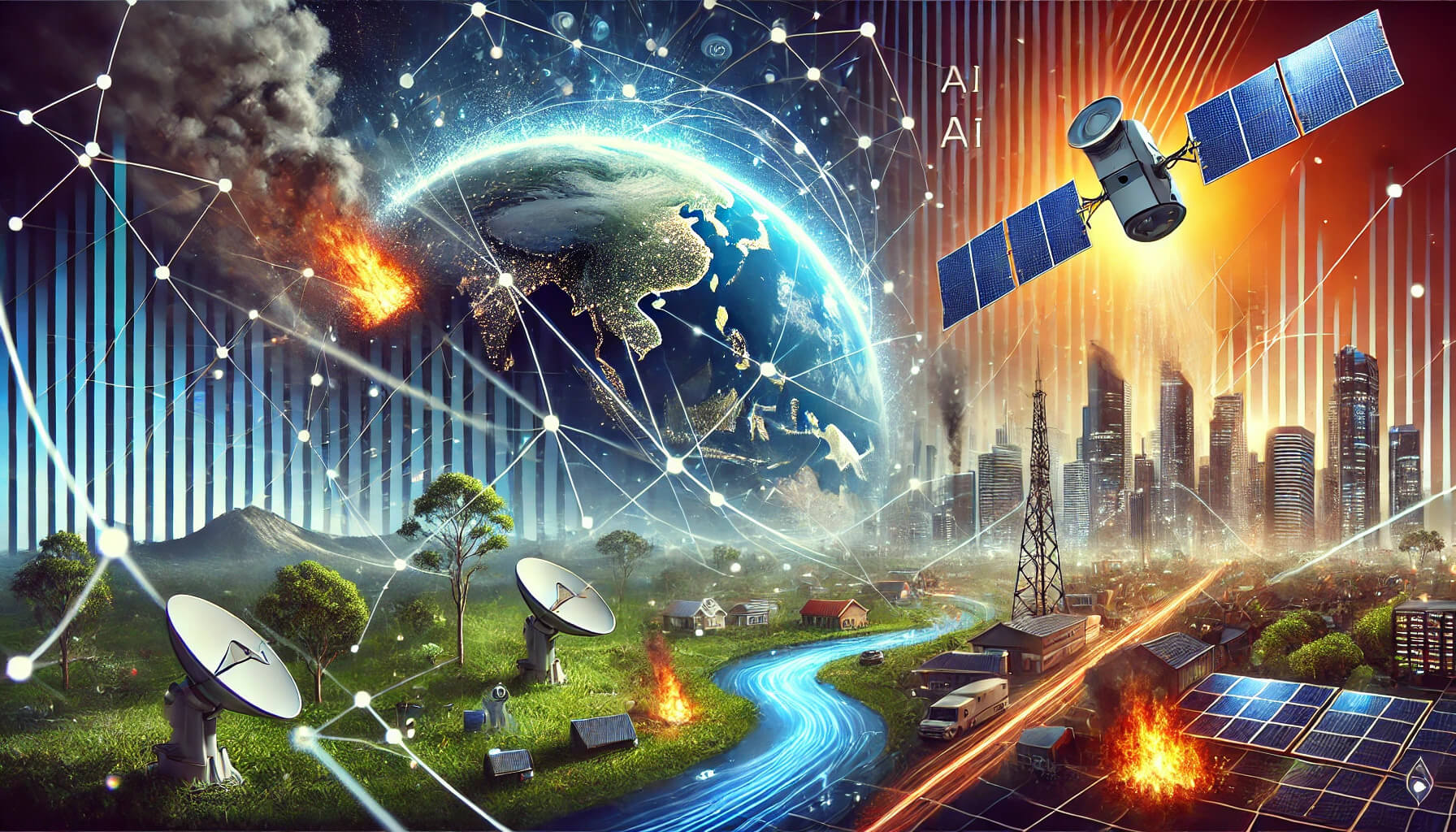The Ripple Effect
A single pebble dropped in water creates ripples that spread far and wide.
Similarly, a minor fluctuation in atmospheric pressure can be the harbinger of a major storm.
In the last decade, natural disasters have affected over 4 billion people and caused over $1.6 trillion in economic losses globally. Behind each number is a story of disrupted lives and communities.
AI in disaster management works on the principle of the ripple effect.
High above Earth, satellites orbit silently, their eyes fixed on the subtle changes occurring across the globe. On the ground, sensors embedded deep in the earth or floating in the ocean add layers of understanding to a global network.
This network, powered by AI, acts as an unseen sentinel—ever-watchful, ever-analysing.
It’s a guardian that doesn’t sleep but constantly learns and adapts, using small data inputs to create expansive waves of predictive insights. These AI-generated ripples are mapping potential disaster zones, deploying aid, and alerting populations, proving that even the smallest data point can be part of a larger solution to combat nature’s unpredictability.
The Power of AI in Predicting Natural Disasters
Artificial Intelligence (AI) stands at the forefront of revolutionising disaster management strategies, particularly in predicting natural disasters with unprecedented accuracy and speed.
- Harnessing AI for Comprehensive Disaster Forecasting
AI-driven predictive models utilise vast datasets, including satellite imagery, historical weather data, and real-time environmental inputs, to anticipate natural disasters before they strike. These models are not just reactive but proactive, continuously learning and improving from each event, making them increasingly precise in their forecasts.
- Predicting Bushfires
Battle with bushfires is well-known, and AI can significantly augment efforts to predict and manage these fires. By analysing factors such as temperature fluctuations, land dryness, and historical fire incidents, AI models can forecast potential bushfire outbreaks with high accuracy.
This allows for preemptive actions, such as mobilising firefighting resources and issuing timely evacuation orders to at-risk communities, potentially saving lives and properties.
- Cyclone Tracking and Management
For a continent frequently hit by cyclones, AI’s ability to predict the path and intensity of these storms is invaluable. By processing data from atmospheric sensors and satellite feeds, AI can provide early warnings to coastal areas, enhancing preparedness and reducing the cyclone’s impact on these vulnerable regions.
- Flood Prediction
In areas prone to sudden and severe flooding, AI can analyse rainfall data and river levels to predict flooding events. This predictive power is crucial for timely evacuations and for managing dams and water systems to mitigate the effects of floods, especially in regions where tropical rains can quickly lead to dangerous flooding conditions.
- Drought Forecasting
AI’s role in predicting drought involves analysing patterns from climatic data over time. For farmers and agricultural sectors, AI can provide early warnings of extended dry periods, aiding in water conservation efforts and crop planning to endure harsh conditions.
- Real-time Data Processing: The Backbone of AI Predictive Models
The strength of AI in disaster prediction lies in its capability to process and analyse data in real time. This allows AI models to dynamically update and refine their forecasts as new data becomes available, providing authorities and the public with the most current information possible.
- Dynamic Updates and Alerts
As conditions change, AI systems adjust their predictions, ensuring that all stakeholders have access to the latest data. This is particularly crucial during fast-developing situations, such as when a bushfire is rapidly spreading or a cyclone is shifting its course.
- Enhanced Decision-making
With accurate, real-time information, decision-makers can better strategize responses and allocate resources more effectively, ultimately leading to reduced disaster impacts and quicker recovery times.
- The Future Trajectory of AI in Disaster Management
Looking ahead, the integration of more advanced AI technologies promises to further enhance the predictive accuracy of these models. Developments in machine learning algorithms and the increasing availability of environmental data are set to refine AI’s predictive capabilities, making it an even more integral part of disaster response and management strategies in Australia.
AI-enhanced Response Strategies: Optimising Disaster Management
In the immediate aftermath of natural disasters, the management of resources and coordination of rescue efforts are crucial. Artificial Intelligence (AI) is transforming these critical response strategies through sophisticated data analysis and real-time decision-making. By integrating AI into emergency response protocols, authorities can optimise the deployment of resources, enhance communication, and ultimately save lives.
- Smart Resource Distribution
AI systems utilise predictive data to map out disaster impacts and assess the needs of affected regions. For instance, in the wake of a cyclone, AI can predict which areas will suffer the most severe impacts and calculate the required amount of emergency supplies such as food, water, and medical kits.
Using algorithms that consider current inventory levels, proximity, and accessibility, AI efficiently allocates resources across affected areas. This targeted distribution ensures that supplies reach those in dire need swiftly, avoiding wastage and redundancy.
- Dynamic Re-routing and Delivery
The logistical challenge of navigating through disaster-hit zones is significantly mitigated by AI-driven routing systems. These systems use real-time traffic data, road conditions, and ongoing environmental assessments to guide emergency vehicles through the safest and fastest routes.
In scenarios like urban flooding, where roads may quickly become impassable, AI’s dynamic routing can be lifesaving, ensuring that rescue and medical teams reach trapped residents in time.
- Automated Emergency Response Coordination
AI’s capability extends beyond logistics to the automation of emergency response coordination. By integrating with despatch systems, AI automates the assignment of rescue missions based on a variety of critical factors.
These include the proximity of response units, the type of disaster, the specific needs of the incident, and the capacity of available units. This automated coordination maximises the efficiency of responses, significantly reducing the time it takes to act in crisis situations.
- Real-time Monitoring and Adjustments
One of AI’s most impactful contributions is its ability to monitor situations in real-time and adjust plans accordingly. As conditions evolve during a disaster—such as a bushfire spreading to new areas—AI systems update their strategies.
This continual adjustment process ensures that responses remain relevant and that resources are redirected to where they are most needed as the situation develops.
- Enhancing Communication and Information Flow
Effective disaster management requires impeccable communication. AI enhances the flow of information, ensuring clarity and timeliness. It synthesises updates from various sources—weather stations, ground reports, satellite feeds—and disseminates crucial information through diverse channels.
This broad broadcasting ensures that both responders and the public receive timely updates essential for safe and effective action.
Recovery and Rebuilding With AI: Accelerating Post-disaster Resilience
After the initial emergency response, the focus shifts to recovery and rebuilding—a phase where AI proves invaluable. AI systems analyse damage, prioritise recovery tasks, and play a strategic role in planning long-term rebuilding efforts. By streamlining these processes, AI not only accelerates recovery but also enhances the resilience of communities against future disasters.
- AI-driven Damage Assessment
In the aftermath of disasters, a quick and accurate damage assessment is crucial. AI steps in to analyse aerial images from drones and satellites, providing rapid assessments that would take humans days, if not weeks, to complete.
- Rapid Structure Analysis
AI algorithms assess the structural integrity of buildings and infrastructure, identifying areas with the most severe damage. This quick categorisation helps direct repair crews to the most critical sites, facilitating faster repairs and reducing the risk of secondary incidents, such as collapses or infrastructure failures.
- Environmental Impact Assessments
Beyond buildings, AI evaluates the environmental impact of disasters, such as soil erosion, water contamination, or vegetation loss. This broad assessment helps environmental agencies plan and implement recovery actions that mitigate the long-term ecological effects of disasters.
- Planning and Reconstruction with AI
With the initial damage assessments in hand, AI aids in the planning and reconstruction phase, using predictive models to ensure that rebuilding efforts are sustainable and resilient.
- Simulating Reconstruction Scenarios
AI models various rebuilding strategies, assessing their potential impacts on the community and the environment. This simulation helps planners choose the most effective strategies that promote safety and sustainability.
- Resource Optimisation
AI optimises the allocation of resources for rebuilding efforts, ensuring that materials, labour, and financial investments are used efficiently. This optimisation prevents resource wastage and expedites the overall recovery process.
- Enhancing Community Resilience
AI not only focuses on physical rebuilding but also on strengthening the community’s resilience to future disasters.
- Predictive Risk Models
Post-disaster, AI develops refined risk models that predict potential future disasters with greater accuracy. These models are crucial for communities frequently facing natural calamities, helping them prepare more effectively.
- Community Engagement Platforms
AI-powered platforms facilitate better communication and engagement with residents during the recovery phase. These platforms provide regular updates, gather feedback on recovery efforts, and educate the public on disaster preparedness.
Overcoming Challenges: Integrating AI in Disaster Management
The adoption of AI in disaster management involves navigating a complex landscape of technological, ethical, and interoperability challenges. Addressing these challenges is essential for harnessing AI’s full potential in enhancing disaster response and recovery efforts.
- Technological Integration and Interoperability
Seamless integration of AI systems across different levels of disaster management operations is crucial for effective implementation.
- System Compatibility
AI systems must be compatible with existing disaster management technologies. This includes ensuring that AI solutions can communicate and share data effectively with legacy systems used by emergency services, NGOs, and government bodies.
- Data Standardisation
To facilitate effective data exchange and interoperability, there is a need for standardised data formats and protocols. AI systems require a consistent framework to analyse and interpret the diverse data sets collected from various sources during disasters.
- Addressing Ethical Concerns
The deployment of AI in scenarios that affect human lives carries significant ethical implications. Ensuring that these systems operate within established ethical guidelines is paramount.
- Bias and Fairness
AI systems must be designed to avoid biases that could affect decision-making processes, particularly in resource allocation and rescue operations. Ensuring fairness involves regular audits of AI algorithms to detect and mitigate any biased outcomes.
- Transparency and Accountability
Maintaining transparency in how AI systems make decisions is crucial for building trust among stakeholders and the public. There should be clear documentation and accountability mechanisms to explain AI-driven decisions, especially those involving prioritisation during emergencies.
- Facilitating Multi-Agency Collaboration
Effective disaster management requires coordinated efforts across various agencies and organisations. AI can play a pivotal role in enhancing this collaboration.
- Unified Communication Platforms
Implementing AI-driven platforms that can integrate inputs from multiple agencies to provide a unified operational picture during disasters. These platforms can facilitate real-time information sharing and decision-making.
- Training and Joint Exercises
Organising joint training sessions and simulation exercises that incorporate AI tools can help different agencies understand how to work together using new technologies. This training ensures that all parties are prepared and can collaborate effectively during actual disaster scenarios.
Future Directions: Ethical AI in Disaster Management
Looking ahead, the integration of AI into disaster management will continue to evolve, with a strong emphasis on ethical implications and enhanced interoperability.
- Developing Ethical AI Frameworks
There will be an increased focus on developing robust ethical frameworks that guide the deployment of AI in sensitive areas. These frameworks will likely involve input from technologists, ethicists, policymakers, and community representatives.
- Advancements in AI Technology
Ongoing advancements in AI will continue to improve the efficiency and effectiveness of disaster management. These developments will bring about more sophisticated algorithms capable of handling complex scenarios with greater accuracy and ethical considerations.
Steering Towards a Safer Future with AI
The advent of Artificial Intelligence in disaster management marks a significant leap forward in our ability to predict, respond to, and recover from natural disasters. AI’s capacity to analyse vast datasets and provide real-time, actionable insights can drastically reduce the human and economic toll of disasters.
As we have explored, from predicting bushfires in Australia to optimising resource distribution during floods, AI is not just a tool; it’s a game-changer in the realm of emergency management.
Leveraging AI for Enhanced Disaster Preparedness
As we navigate the complexities of integrating AI into disaster management, tools like MetaOPT stand out by offering advanced analytics and optimisation capabilities. MetaOPT can significantly enhance predictive accuracy, streamline resource allocation, and improve overall emergency response strategies.
FAQs
- How Does AI Predict Natural Disasters With Accuracy?
AI utilises machine learning algorithms that analyse vast amounts of data from various sources, including satellite imagery, weather stations, and historical disaster data. By identifying patterns and anomalies in this data, AI can forecast potential disasters before they occur with a high degree of accuracy.
- What Are the Primary Benefits of Using AI in Disaster Management?
The primary benefits include enhanced predictive accuracy, improved resource allocation, faster response times, and more effective recovery strategies. AI enables more informed decision-making, which can significantly mitigate the impact of disasters on affected communities.
- Can AI in Disaster Management Work in Real-time?
Yes, one of AI’s strengths is its ability to process and analyse data in real time. This capability allows AI systems to continuously update predictions and strategies as new data becomes available, providing emergency responders with the most current insights during a disaster.
- What Are the Challenges in Implementing AI for Disaster Management?
Challenges include integrating AI with existing emergency management systems, ensuring data privacy and security, overcoming potential biases in AI algorithms, and securing sufficient funding for AI initiatives. Training personnel to effectively use AI tools is also a significant challenge.
- How Is AI Used in the Recovery Phase of a Disaster?
AI assists in the recovery phase by quickly analysing damage through satellite and aerial imagery, helping to assess the severity and extent of impact. It also aids in planning and optimising reconstruction efforts, predicting future risks, and preparing for potential subsequent disasters.
- Are There Ethical Concerns With Using AI in Disaster Management?
Yes, ethical concerns include the potential for data misuse, privacy issues, and the risk of AI systems making decisions that could prioritise resources unfairly. Establishing clear ethical guidelines and continuous monitoring of AI systems are critical to addressing these concerns.
- How Can Communities Better Prepare for AI Integration in Disaster Management?
Communities can prepare by participating in educational programmes about AI, engaging in public discussions to set local priorities for AI use, and collaborating with technologists to tailor AI solutions to meet specific local needs. Public-private partnerships can also play a crucial role in developing community-focused AI applications.







No comment yet, add your voice below!